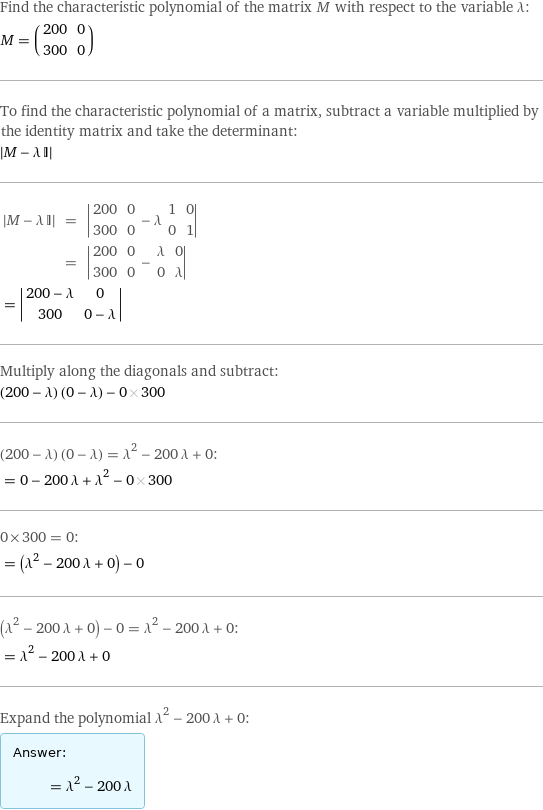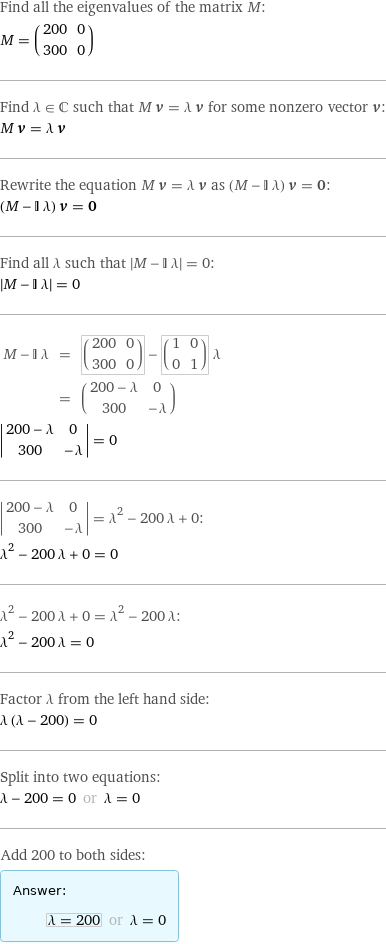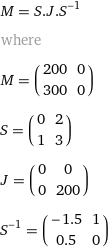Input interpretation

tungsten carbide | vertex coordinates
Result

(200 | 0 300 | 0)
Characteristic polynomial

λ^2 - 200 λ
Possible intermediate steps

Find the characteristic polynomial of the matrix M with respect to the variable λ: M = (200 | 0 300 | 0) To find the characteristic polynomial of a matrix, subtract a variable multiplied by the identity matrix and take the determinant: left bracketing bar M - λ I right bracketing bar left bracketing bar M - λ I right bracketing bar | = | left bracketing bar 200 | 0 300 | 0 - λ 1 | 0 0 | 1 right bracketing bar | = | left bracketing bar 200 | 0 300 | 0 - λ | 0 0 | λ right bracketing bar invisible comma = left bracketing bar 200 - λ | 0 300 | 0 - λ right bracketing bar Multiply along the diagonals and subtract: (200 - λ) (0 - λ) - 0 300 (200 - λ) (0 - λ) = λ^2 - 200 λ + 0: = 0 - 200 λ + λ^2 - 0 300 0×300 = 0: = (λ^2 - 200 λ + 0) - 0 (λ^2 - 200 λ + 0) - 0 = λ^2 - 200 λ + 0: = λ^2 - 200 λ + 0 Expand the polynomial λ^2 - 200 λ + 0: Answer: | | = λ^2 - 200 λ
Eigenvalues

λ_1 = 200

λ_2 = 0
Possible intermediate steps

Find all the eigenvalues of the matrix M: M = (200 | 0 300 | 0) Find λ element C such that M v = λ v for some nonzero vector v: M v = λ v Rewrite the equation M v = λ v as (M - I λ) v = 0: (M - I λ) v = 0 Find all λ such that left bracketing bar M - I λ right bracketing bar = 0: left bracketing bar M - I λ right bracketing bar = 0 M - I λ | = | (200 | 0 300 | 0) - (1 | 0 0 | 1) λ | = | (200 - λ | 0 300 | -λ) invisible comma left bracketing bar 200 - λ | 0 300 | -λ right bracketing bar = 0 left bracketing bar 200 - λ | 0 300 | -λ right bracketing bar = λ^2 - 200 λ + 0: λ^2 - 200 λ + 0 = 0 λ^2 - 200 λ + 0 = λ^2 - 200 λ: λ^2 - 200 λ = 0 Factor λ from the left hand side: λ (λ - 200) = 0 Split into two equations: λ - 200 = 0 or λ = 0 Add 200 to both sides: Answer: | | λ = 200 or λ = 0
Eigenvectors

v_1 = (2, 3)

v_2 = (0, 1)
Possible intermediate steps

Find all the eigenvalues and eigenvectors of the matrix M: M = (200 | 0 300 | 0) Find λ element C such that M v = λ v for some nonzero vector v: M v = λ v Rewrite the equation M v = λ v as (M - I λ) v = 0: (M - I λ) v = 0 Find all λ such that left bracketing bar M - I λ right bracketing bar = 0: left bracketing bar M - I λ right bracketing bar = 0 M - I λ | = | (200 | 0 300 | 0) - (1 | 0 0 | 1) λ | = | (200 - λ | 0 300 | -λ) invisible comma left bracketing bar 200 - λ | 0 300 | -λ right bracketing bar = 0 left bracketing bar 200 - λ | 0 300 | -λ right bracketing bar = λ^2 - 200 λ + 0: λ^2 - 200 λ + 0 = 0 λ^2 - 200 λ + 0 = λ^2 - 200 λ: λ^2 - 200 λ = 0 Factor λ from the left hand side: λ (λ - 200) = 0 Split into two equations: λ - 200 = 0 or λ = 0 Add 200 to both sides: λ = 200 or λ = 0 Find all v such that (M - I λ) v = 0 for some eigenvalue λ: (M - I λ) v = 0 Substitute (200 - λ | 0 300 | -λ) for (M - I λ): (200 - λ | 0 300 | -λ) v = 0 Write v as (v_1 v_2) and 0 as (0 0): (200 - λ | 0 300 | -λ).(v_1 v_2) = (0 0) First, substitute 200 for λ in the matrix (200 - λ | 0 300 | -λ) and solve the system: (0 | 0 300 | -200).(v_1 v_2) = (0 0) Multiply both sides of the equation by (0 | 0.00333333333333333333333333333333 1 | 0): (0 | 0.00333333333333333333333333333333 1 | 0)(0 | 0 300 | -200)(v_1 v_2) = (0 | 0.00333333333333333333333333333333 1 | 0)(0 0) Performing the relevant matrix multiplications on the above equation yields: (1 | -0.666666666666666666666666666667 0 | 0)(v_1 v_2) = (0 0) As a scalar equation, the system (1 | -0.666666666666666666666666666667 0 | 0)(v_1 v_2) = (0 0) translates to: v_1 - 0.666666666666666666666666666667 v_2 = 0 Rewrite the equation as: v_1 = 0.666666666666666666666666666667 v_2 According to the above equation: v = (v_1 v_2) = (0.666666666666666666666666666667 v_2 v_2) Letting v_2 = 1 in (0.666666666666666666666666666667 v_2 v_2), we find that (0.666666666666666666666666666667 1) is an eigenvector of the matrix (200 | 0 300 | 0) associated with the eigenvalue 200: v = (0.666666666666666666666666666667 1) Substitute 0 for λ in the matrix (200 - λ | 0 300 | -λ) and solve the system: (200 | 0 300 | 0).(v_1 v_2) = (0 0) Multiply both sides of the equation by (0 | 0.00333333333333333333333333333333 1 | -0.666666666666666666666666666667): (0 | 0.00333333333333333333333333333333 1 | -0.666666666666666666666666666667)(200 | 0 300 | 0)(v_1 v_2) = (0 | 0.00333333333333333333333333333333 1 | -0.666666666666666666666666666667)(0 0) Performing the relevant matrix multiplications on the above equation yields: (1 | 0 0 | 0)(v_1 v_2) = (0 0) As a scalar equation, the system (1 | 0 0 | 0)(v_1 v_2) = (0 0) translates to: v_1 = 0 According to the above equation: v = (v_1 v_2) = (0 v_2) Letting v_2 = 1 in (0 v_2), we find that (0 1) is an eigenvector of the matrix (200 | 0 300 | 0) associated with the eigenvalue 0: v = (0 1) We found the following eigenvalue/eigenvector pair: Answer: | | Eigenvalue | Eigenvector 200 | (0.666666666666666666666666666667 1) 0 | (0 1)
Diagonalization

M = S.J.S^(-1) where M = (200 | 0 300 | 0) S = (0 | 2 1 | 3) J = (0 | 0 0 | 200) S^(-1) = (-1.5 | 1 0.5 | 0)